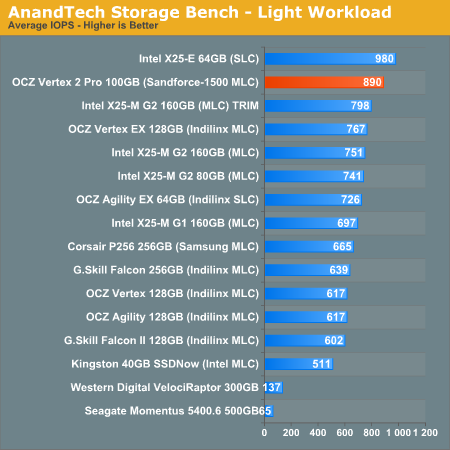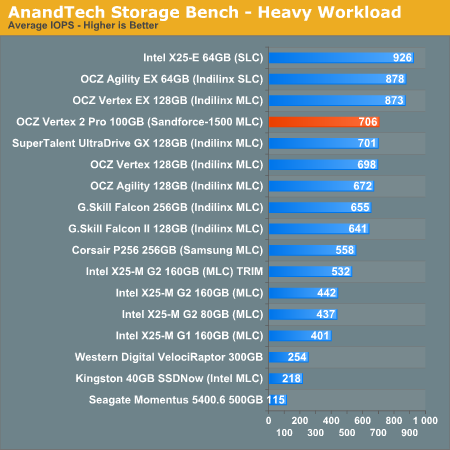OCZ's Vertex 2 Pro Preview: The Fastest MLC SSD We've Ever Tested
by Anand Lal Shimpi on December 31, 2009 12:00 AM EST- Posted in
- Storage
AnandTech Storage Bench
I introduced our storage suite in our last SSD article and it’s back, now with more data :)
Of the MLC SSDs represented here, there’s just nothing faster than the SandForce based OCZ Vertex 2 Pro.
Intel’s SLC based X25-E actually does very well, especially for a controller that’s as old as it is. It is worth noting however that the only thing separating Intel from SandForce-level performance is the X25-M’s low sequential write speed...
The first in our benchmark suite is a light usage case. The Windows 7 system is loaded with Firefox, Office 2007 and Adobe Reader among other applications. With Firefox we browse web pages like Facebook, AnandTech, Digg and other sites. Outlook is also running and we use it to check emails, create and send a message with a PDF attachment. Adobe Reader is used to view some PDFs. Excel 2007 is used to create a spreadsheet, graphs and save the document. The same goes for Word 2007. We open and step through a presentation in PowerPoint 2007 received as an email attachment before saving it to the desktop. Finally we watch a bit of a Firefly episode in Windows Media Player 11.
There’s some level of multitasking going on here but it’s not unreasonable by any means. Generally the application tasks proceed linearly, with the exception of things like web browsing which may happen in between one of the other tasks.
The recording is played back on all of our drives here today. Remember that we’re isolating disk performance, all we’re doing is playing back every single disk access that happened in that ~5 minute period of usage. The light workload is composed of 37,501 reads and 20,268 writes. Over 30% of the IOs are 4KB, 11% are 16KB, 22% are 32KB and approximately 13% are 64KB in size. Less than 30% of the operations are absolutely sequential in nature. Average queue depth is 6.09 IOs.
The performance results are reported in average I/O Operations per Second (IOPS):

If there’s a light usage case there’s bound to be a heavy one. In this test we have Microsoft Security Essentials running in the background with real time virus scanning enabled. We also perform a quick scan in the middle of the test. Firefox, Outlook, Excel, Word and Powerpoint are all used the same as they were in the light test. We add Photoshop CS4 to the mix, opening a bunch of 12MP images, editing them, then saving them as highly compressed JPGs for web publishing. Windows 7’s picture viewer is used to view a bunch of pictures on the hard drive. We use 7-zip to create and extract .7z archives. Downloading is also prominently featured in our heavy test; we download large files from the Internet during portions of the benchmark, as well as use uTorrent to grab a couple of torrents. Some of the applications in use are installed during the benchmark, Windows updates are also installed. Towards the end of the test we launch World of Warcraft, play for a few minutes, then delete the folder. This test also takes into account all of the disk accesses that happen while the OS is booting.
The benchmark is 22 minutes long and it consists of 128,895 read operations and 72,411 write operations. Roughly 44% of all IOs were sequential. Approximately 30% of all accesses were 4KB in size, 12% were 16KB in size, 14% were 32KB and 20% were 64KB. Average queue depth was 3.59.

Our final test focuses on actual gameplay in four 3D games: World of Warcraft, Batman: Arkham Asylum, FarCry 2 and Risen, in that order. The games are launched and played, altogether for a total of just under 30 minutes. The benchmark measures game load time, level load time, disk accesses from save games and normal data streaming during gameplay.
The gaming workload is made up of 75,206 read operations and only 4,592 write operations. Only 20% of the accesses are 4KB in size, nearly 40% are 64KB and 20% are 32KB. A whopping 69% of the IOs are sequential, meaning this is predominantly a sequential read benchmark. The average queue depth is 7.76 IOs.











100 Comments
View All Comments
Howard - Friday, January 1, 2010 - link
Did you REALLY mean 90 millifarads (huge) or 90 uF, which is much more reasonable?korbendallas - Saturday, January 2, 2010 - link
Yep, it's 0.09F 5.5V Supercapacitor.http://www.cap-xx.com/images/HZ202HiRes.jpg">http://www.cap-xx.com/images/HZ202HiRes.jpg
iwodo - Friday, January 1, 2010 - link
If, all things being equal, it just shows that the current SSD drives performance aren't really limited by Flash itself but the controller.So may be with a Die Shrink we could get even more Random RW performance?
And i suspect these SSD aren't even using ONFI 2.1 chips either, so 600MB/s Seq Read is very feasible. Except SATA 3.0 is holding it all up.
How far are we from using PCI-Express based SSD? I am sure booting problem could be easily solved with UEFI,
ProDigit - Friday, January 1, 2010 - link
One of the factors would be if this drive has a processor that does real life compression of files on the SSD,that would mean that it would use more power on notebooks.Sure it's performance is top, as well as it's length in time that it works, but how much power does it use?
If it still is close to an HD it might be an interesting drive. But if it is more, it'd be interesting to see how much more!
I'm not interested in equipping a netbook or notebook/laptop with a SSD that uses more than 5W TDP.
chizow - Friday, January 1, 2010 - link
I've always noticed the many similarities between SSD controller technology and RAID technology with the multiple channel modules determining reads/write speeds along with write differences between MLC and SLC. The differences in SandForce's controller seems to take this analogy a step further with what is essentially RAID 5 compared to previous MLC SSDs.It seems like these drives use a lot of controller/processor power for redundancy/error checking code, which is very similar to a RAID 5 array. This allows them to do away with DRAM and gives them the flexibility to use cheaper NAND Flash, but at the expense of additional Flash capacity to store the parity/ECC data. I guess that begs the question, is 64MB of DRAM and the difference in NAND quality used more expensive than 30% more NAND Flash? Right now I'd say probably not until cheaper NAND becomes available, but if so it may make their technology more viable to widespread desktop adoption when that
Last thing I'll say is I think its a bit scary how much impact Anand's SSD articles have on this emerging market. He's like the Paul Muad'dib of SSDs and is able to kill a controller-maker with a single word lol. Seriously, after he exposed the stuttering and random read/write problems on Jmicron controllers back when OCZ first started using them, the mere mention of their name combined with SSDs has been taboo. OCZ has clearly recovered since then, as their Vertex drives have been highly regarded. I expect SandForce-based controllers to be all the buzz now going forward, largely because of this article.
pong - Friday, January 1, 2010 - link
It seems to me that Anand may be misunderstanding the reason for the impressive write amplification. The example with Windows Vista install + Office 2007 install states that 25GB is written to the disk, but only 11GB is written to flash. I don't believe this implies compression. It just means that a lot of the data written to disk is shortlived because it lives in temporary files which are deleted soon after or because the data is overwritten with more recent information. The 11GB is what ends up being on the disk after installation whether it is an SSD or a normal hard-drive. If the controller has significantly more RAM than other SSD controllers it doesn't have to commit short-lived changes to flash as often. The controller may also have logic that enables it to detect hotspots, ie areas of the logical disk that is written to often to improve the efficiency of its caching scheme. This sort of stuff could probably be implemented mostly in an OS except the OS can't guarantee that the stuff in the cache will make it to the disk if the power is suddenly cut. The SSD controller can make this guarantee if it can store enough energy - say in a large capacitor - to commit everything it has cached to flash when power is removed.shawkie - Friday, January 1, 2010 - link
Unless I misread it the article seems be claiming that the device actually has no cache at all.bji - Friday, January 1, 2010 - link
I think the article said that the SSD has no RAM external to the controller chip, but that the controller chip itself likely has some number of megabytes of RAM, much of which is likely used for cache. It's not clear, but it's very, very hard to believe that the device could work without any kind of internal buffering; but that this device does it with less DRAM than other SSDs (i.e., the smaller amount of DRAM built into the controller chip versus a separate external tens-of-megabytes DRAM chip).gixxer - Friday, January 1, 2010 - link
I thought the vertex supported Trim thru windows 7, yet in the article Anand says this:"With the original Vertex all you got was a command line wiper tool to manually TRIM the drive. While Vertex 2 Pro supports Windows 7 TRIM, you also get a nifty little toolbox crafted by SandForce and OCZ:"
Does the Vertex drive support windows 7 trim or do you still have to use the manual tool?
MrHorizontal - Friday, January 1, 2010 - link
Very interesting controller, though they've seemed to have missed a couple of tricks...First why is an 'enterprise' controller like this not using SAS which is at 6GBps right now and we can see what effect a non-3GBps interface has on SSDs, and why when SATA 6GBps is being shipped in motherboards now, then in 2010, when these SandForce drives are going to be released will still be using 3GBps SATA...
Second, the 'RAID' features of this drive seem to be like RAID5 distributing parity hashes across the spare area which is also distributed across the drive. However, all controllers have multiple channels and why they don't use RAID6 (the one where a dedicated drive holds parity data, not the 2-stripe RAID5) whereby they use 1 or 2 SLC NAND Flash chips to hold the more important data, and use really cheap MLC NAND to hold the actual data in a redundant manner?